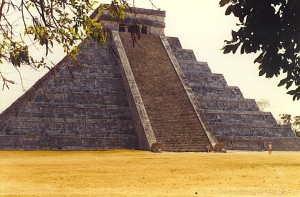If there is a stretch of road on the island of Nuku Hiva that is straight and level for more than 100 meters, we never saw it.
In places the roads are paved, but in others they were rock collections little more than the width of one 4-wheel drive vehicle. For the record, cars drive on the right. As a practical matter, though, Nuku Hivans drive on whatever side of the road will do the least damage to their cars. It also seems to be local custom to yield to horses, cows, chickens and other livestock which share these roads.
Nuku Hiva is the largest of the group of islands known as the Marquesas, which are part of French Polynesia. If you’re picturing sandy tropical beaches fringing turquoise water, that’s not the Marquesas; they are gorgeous in a different way than, say, Bora Bora. The roads I mentioned climb the sides of jagged volcanic peaks and then spin their way down through forests of fir and pine and acacia… and also breadfruit and mango.
Sometimes we would come around a curve on Nuku Hiva and see a vast expanse of ocean; other times we’d see valleys with farmland that reminded us a bit of central New York state. There are beaches here, too — quite beautiful ones — but many of them are more accessible by boat than from land because of the steep cliffs that surround them.
One night we talked to a couple of sailors who had recently arrived in Taiohae Bay (where we were staying) on a ketch that had left from England three months before. In this part of the Pacific Ocean, they didn’t have too many options if they wanted to get fresh provisions and launder their delicates. Mexico, the nearest continental land mass, is something like 4,000 miles northeast of Nuku Hiva, and Tahiti is almost 1,000 miles farther south.
Well, I suppose they could have gone to Hiva Oa, another Marquesan island. It’s only 100 miles or so to the southeast of Nuku Hiva, and is just as visually stunning. It also has the distinction of being the island where Paul Gauguin lived his final couple of years.
The famous French Post-Impressionist painter is buried in a cemetery that overlooks the small town of Atuona. (Actually, all of the towns in the Marquesas are small; the combined population of the islands is less than 10,000.)
There is also a museum in Atuona that has reproductions of many of Gauguin’s paintings. Across the street from it is a general store where you can buy a bottle of cold water, and behind the Gauguin Center is a building that houses some memorabilia of a Belgian singer/songwriter named Jacques Brel. He is also buried on Hiva Oa, just a few steps from Paul Gauguin. Other notable people who spent time in these islands include Herman Melville and Robert Louis Stevenson, who wrote a book that, by sheer coincidence, has the same title as this blog post.
A peculiarity of the Marquesas is the time zone, which is a half-hour ahead of the Society Islands, so when it’s 7:00 in Tahiti, it’s 7:30 in Hiva Oa. There are also language differences between those different island cultures which I won’t even attempt to explain, since I don’t have a clue what they are.
An endearing thing about the people of the Marquesas was that when we were unable to communicate with words, they spoke to us with gestures and smiles. And even though some of them had never been anywhere else in the world, they somehow knew that they lived in one of the world’s most beautiful places.





